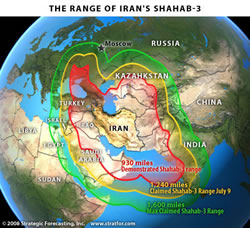Today's missile, rocket, and mortar threats to our armed forces deployed throughout the middle East are severe and growing. The number one killer of U.S. troops on forward operating bases is rocket and mortar fire. Iran continues to test and deploy vast quantities of short-and medium-range missiles that are within the hundred-mile range and beyond of our thousands of men and women serving the United States military in forward operating bases around the Persian Gulf. To this extent, MDAA has submitted a brief educational paper on U.S. Army needs for protecting our men and women overseas. It is included below for your review and understanding.
Threat
The ballistic missile arsenals of Iran and North Korea directly threaten U.S. bases in Iraq, Kuwait, Bahrain, Qatar, United Arab Emirates (UAE), South Korea, and Japan. In 2010, South Korea reported a North Korean arsenal of 1000 missiles, a 25% increase over the past two years. The country has also greatly expanded its uranium enrichment program. The Iranian ballistic missile arsenal is upwards of 600 missiles and growing. In July of this year, Iran tested 14 missiles at the same time, proving the coordination and salvo/raid capability to overwhelm U.S. and allied defenses. Moreover, the rocket and mortar attacks against forward operating bases in Iraq and Afghanistan remain the number one killer of U.S. deployed soldiers. Long-range ballistic missile programs are being developed and tested by North Korea and Iran with potential capability to strike as early as 2015, as stated in congressional testimonies by the current administration. In addition, Israel remains threatened by short-and medium-range ballistic missiles from its neighbors in the region; the United States has a responsibility to defend Israel.
Deployed Systems
There are seven major Army Air Defense Artillery (ADA) systems and one Space and Missile Defense Command /Army Strategic Command (SMDC/ARSTRAT) system. Five are deployed today in EUCOM, PACOM, CENTCOM and NORCOM, and two other systems will soon be deployed to those regions. Three systems are still in development and testing stages, including the Ground-Based Midcourse Defense system (GMD).
Deployed:
- Counter-Rocket, Artillery, and Mortar (C-RAM): Defensive system with sensors, warning towers, and rapid-fire weapons.
- Avenger: Short-range air defense system to counter aircrafts, cruise missiles, UAVs, and helicopters made up of rapid-firing launch pods and infrared-guided missiles.
- Patriot Advanced Capability (PAC-3 and PAC-2): Anti-aircraft, anti-cruise, anti-ballistic missiles of short-and medium-range for terminal-phase intercepts that uses tracking and fire control radars. PAC-3 uses hit-to-kill kinetic energy intercept technology while PAC-2 uses blast fragmentation technology.
Soon to be deployed and transitioned over to the U.S. Army:
- Terminal High Altitude Area Defense (THAAD): Counters high volume short-and medium-range ballistic missiles and operates with X-Band radar tracking and fire control to destroy targets in the terminal and late-midcourse phase using kinetic energy technology interceptors.
- Joint Land Attack Cruise Missile Defense Elevated Sensor System (JLENS): Tethered aerostat radars for surveillance, tracking, and targeting of lower altitude (10,000 ft and below) air-breathing targets.
Development and Testing Stage: Systems too premature to be turned over to the U.S. Army.
- Medium Extended Air Defense System (MEADS): Next generation of a short-range ballistic missile defense. It has 360° detection with two radars of different bandwidths. This system is being developed in partnership with Germany and Italy.
- Surfaced-Launched Advanced Medium Range Air-to-Air Missile (SLAMRAAM): To counter anti-aircraft and anti-cruise missiles.
- Missile Segment Enhancement (MSE): Next generation of the PAC-3 interceptors with increased capability in range and effectiveness.
- Ground-Based Midcourse Defense (GMD): System is deployed but all the Ground-Based Interceptors (GBIs) and sensor upgrades continue to be tested and developed.
Immediate Needs
- More rocket and mortar defense battalions need to be deployed to the U.S. forward operating bases in Iraq and Afghanistan. The Army also needs active duty C-RAM battalions (five batteries and 12 shooters) and additional C-RAM battalions for the National Guard.
- Increase number of PAC-3 missiles and launchers deployed for ballistic missile defense (BMD) in PACOM, CENTCOM and EUCOM, in addition to future AN/TYP-2 X-Band radars and THAAD, to handle discrimination and salvo raids of multiple missiles threatening PACOM and CENTCOM.
- Enhance durability of Patriot radars and power generators deployed, along with more spare parts.
- THAAD release to the U.S. Army
- PAC-3 and THAAD launchers and radars for the soldiers' hands-on training at the Air Defense Artillery (ADA) in Fort Sill, Oklahoma.
- Understand and fix the Exoatmospheric Kill Vehicle (EKV) on the GBIs in the GMD system.
- Test the GBIs against realistic operational scenarios.
Overall Needs
- A fully integrated, tested, and deployed "system of systems" that can link fire-control and sensing information across the different defense systems throughout the theater. This would multiply the force of all deployed sensors and shooters in the region against air-breathing threats and ballistic missiles.
- An AMD General Officer is required to set the conditions for current and future operations in the EUCOM AOR, since the missile threat and the corresponding Air and Missile Defense (AMD) requirements within EUCOM parallel those in CENTCOM and PACOM.
- An additional Patriot battalion for the 357th Air Missile Defense Detachment in EUCOM, as there is only one battalion commanded by an ADA Colonel with responsibility over Israel, Europe, and the European Phased Adapted Approach.
- AN/TYP-2 radar upgrades.
- Complete sensor architecture against Iran to include the Eastern coast of the United States, incorporating a fire-control X-Band radar.
- Development of the next generation Exoatmospheric Kill Vehicle (EKV) for the GBIs.
- Realistic hedge strategy to protect US homeland by 2015 and implementation of upgrades, sensors, modifications, and use of Stage 2 GBI.
- Second shot ICBM defense capability for the Eastern United States coast.
- Maintain Patriot viability.
Future Needs
- Cruise missile defense System and training.
- Unmanned Aerial Systems (UAS) defense and training.
- Next generation Ground Based Interceptor.
- Directed energy missile, rocket, and mortar defense.
- 360 dual band radars for short-range missile defense.
Riki Ellison one of the top Missile Defense Experts in the World, is Founder and Chairman of MDAA. He has more than twenty five years of experience as an advocate for the Deployment and Development of a Missile Defense System for missiles of all ranges.
©Copyright - All Rights Reserved
DO NOT REPRODUCE WITHOUT WRITTEN PERMISSION BY AUTHOR.










